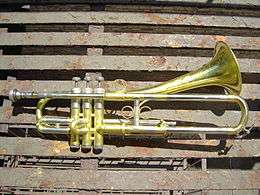Firebird (trumpet)

The Firebird is a type of trumpet with the standard three valves and the addition of a trombone-style slide. It was invented by Maynard Ferguson and Larry Ramirez and remains an exceptionally rare, specialist instrument. They are occasionally produced by Holton.[1]
History
Instruments equipped with both a slide and valves have been in existence since the early 20th century. One popular model was created by C.G. Conn.
Jazz trumpet player Maynard Ferguson and Holton (now a division of C.G. Conn) worked together to develop Ferguson's first trumpet, Model ST302. The designer of that trumpet, Larry Ramirez, spoke to Ferguson about a valve/slide trombone that he had designed some 12 years earlier, and this eventually led to Ramirez designing a new valve/slide trombone for Ferguson, called the Superbone, in October 1974.[2]
After touring with the Superbone, Ferguson spoke to Ramirez about making a trumpet with the same valve/slide capabilities. In order to preserve the length of tubing required to make a B♭ trumpet, the hand slide could only be made with four positions instead of the standard seven on a trombone. In addition, the bell was bent up approximately 20 degrees so that the hand slide could be extended and clear the bell. This instrument was dubbed the “Firebird”, and went into production on or around May 28, 1983.[2] The Firebird is Model ST303.[1]
(Recommended correction) Limited production started in 1978.
By 2000, Ramirez came up with a design for a full seven-position Firebird trumpet. The hand slide was constructed as a telescoping assembly, or a slide within a slide that could be extended to twice its length. One prototype was made for Ferguson and years later a second one was made after the first one was damaged.[2] These two remain the only seven-position Firebird trumpets in existence.
Technique
The Firebird may be played strictly as a valve trumpet, or using the valves and slide in conjunction. With only the first four slide positions available, the lowest G, D, E♭, F♯ and C♯, and every A♭ require the use of valves.
The horn may be gripped with either the left hand or the right hand, and the valves may also be operated by either hand, which is facilitated by the presence of two pinky rings on the top of the horn. Similarly, the slide may be operated by either hand, giving the player the option to finger the valves with the right hand and operate the slide with the left, or vice versa.
Other than the slide, Firebird playing technique is no different from standard trumpet technique.
Specifications
- Model
- ST303[1]
- Key
- B♭[1]
- Bore
- .468 in (11.89 mm)[1]
- Bell
- 5.0” diameter, hand hammered yellow brass with wire enclosed rim, bell tilted 20 degrees[1]
- Leadpipe
- Yellow brass, special taper
- Pistons
- Monel material with double-slotted spring barrel, enclosed stainless steel springs
- Slides
- 1st, 2nd, & 3rd valve slides are nickel silver outside and inside slides
- Hand slide
- Assembly has two finger rings and can be played left- or right-handed. The hand slide assembly has inside tubes that are chrome plated with nickel-silver outers
- Waterkeys
- Standard type on hand slide and 3rd valice slide (early model horns) [1]
- Amado-style on hand slide and 3rd valve slide (late model horns)[1]
Notable Firebird players
Popular artists who have used the Firebird on recordings and live performances include:
References
External links
- Firebird page (archived) on trumpetstuff.com
- Firebird page on konakkol.com
